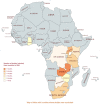Health-related needs reported by adolescents living with HIV and receiving antiretroviral therapy in sub-Saharan Africa: a systematic literature review
- PMID: 35983685
- PMCID: PMC9389275
- DOI: 10.1002/jia2.25921
Health-related needs reported by adolescents living with HIV and receiving antiretroviral therapy in sub-Saharan Africa: a systematic literature review
Abstract
Introduction: Adolescents living with HIV (ALHIV) on antiretroviral therapy (ART) have specific health needs that can be challenging to deliver. Sub-Saharan Africa (SSA) is home to 84% of the global population of ALHIV, of whom about 59% receive ART. Several studies in SSA have demonstrated health service gaps due to lack of synchronized healthcare for ALHIV receiving ART. We conducted a systematic review of health-related needs among ALHIV on ART in SSA to inform decisions and policies on care.
Methods: We searched MEDLINE, Web of Science, EMBASE, PsycINFO, Cochrane library and grey literature for studies reporting health-related needs among ALHIV receiving ART in SSA, between January 2003 and May 2020.
Results and discussion: Of the 2333 potentially eligible articles identified, 32 were eligible. Eligible studies were published between 2008 and 2019, in 11 countries: Zambia (7), Uganda (6), Tanzania (4), South Africa (4), Kenya (3), Ghana (2), Zimbabwe (2), Rwanda (1), Malawi (1), Botswana (1) and Democratic Republic of Congo (1). Seven categories of health needs among ALHIV were identified. In descending order of occurrence, these were: psychosocial needs (stigma reduction, disclosure and privacy support, and difficulty accepting diagnosis); dependency of care (need for family and provider support, and desire for autonomy); self-management needs (desire for better coping strategies, medication adherence support and reduced ART side effects); non-responsive health services (non-adolescent friendly facility services and non-compatible school system); need for food, financial and material support; inadequate information about HIV (desire for more knowledge to fight misinformation and misconception); and developmental and growth needs (desire to experience sex, parenthood and love). Ecological analysis identified different priority needs between ALHIV, their caregivers and healthcare providers, including psychosocial needs, financial challenges and non-responsive health services, respectively.
Conclusions: To respond effectively to the health needs of ALHIV and improve ART adherence, interventions should focus on stigma reduction, disclosure challenges and innovative coping mechanisms for ART. Interventions that address the health needs of ALHIV from the perspective of carers and providers, such as financial support schemes and adolescent-friendly healthcare strategies, should supplement efforts to improve adolescent ART adherence outcomes.
Keywords: ART adherence; HIV; adolescents; antiretroviral therapy; health needs.
© 2022 The Authors. Journal of the International AIDS Society published by John Wiley & Sons Ltd on behalf of the International AIDS Society.
Figures
References
-
- UNICEF . Adolescent HIV prevention: turning the tide against AIDS will require more concentrated focus on adolescents and young people. 2021. Available from https://data.unicef.org/topic/adolescents/hiv‐aids/
-
- Bernays S, Jarrett P, Kranzer K, Ferrand RA. Children growing up with HIV infection: the responsibility of success. Lancet. 2014;383(9925):1355–7. - PubMed
-
- UNICEF . Adolescent demographics. 2019. Available from https://data.unicef.org/topic/adolescents/demographics/
-
- Karim S, Baxter C. HIV incidence rates in adolescent girls and young women in sub‐Saharan Africa. Lancet Glob Health. 2019;7(11): e1470‐e1471 - PubMed
Publication types
MeSH terms
LinkOut - more resources
Full Text Sources
Medical
Research Materials




